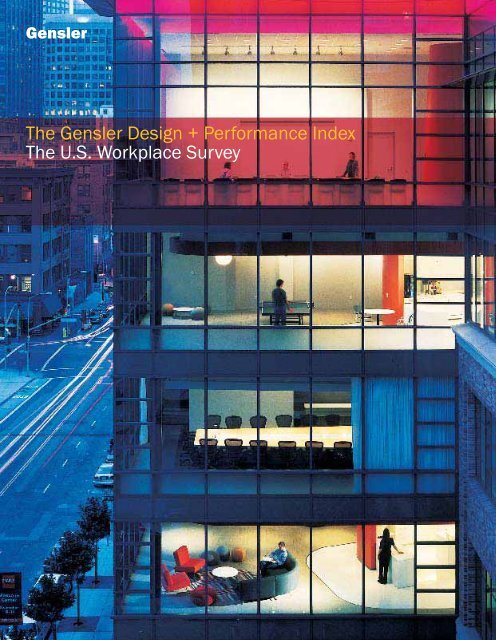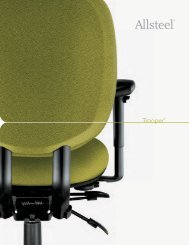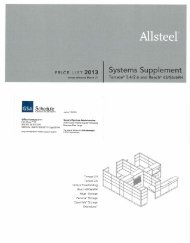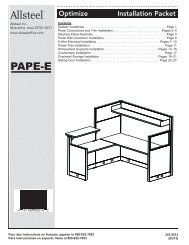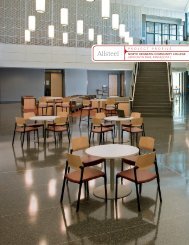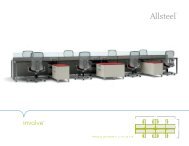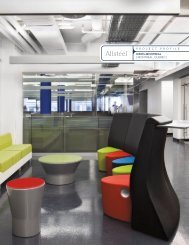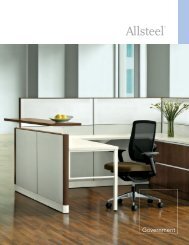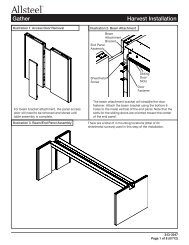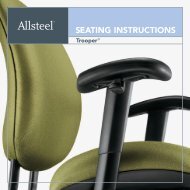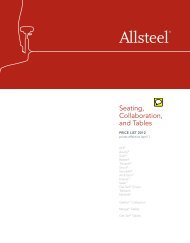The Gensler Design + Performance Index The U.S. Workplace Survey
The Gensler Design + Performance Index The U.S. Workplace Survey
The Gensler Design + Performance Index The U.S. Workplace Survey
Create successful ePaper yourself
Turn your PDF publications into a flip-book with our unique Google optimized e-Paper software.
<strong>Gensler</strong><br />
<strong>The</strong> <strong>Gensler</strong> <strong>Design</strong> + <strong>Performance</strong> <strong>Index</strong><br />
<strong>The</strong> U.S. <strong>Workplace</strong> <strong>Survey</strong>
Contents<br />
<strong>The</strong> <strong>Workplace</strong> in an Age of<br />
Markets<br />
Workforce<br />
Responsibility<br />
Foreword<br />
<strong>The</strong> Evolution of <strong>Workplace</strong> <strong>Design</strong><br />
Research Methodology<br />
<br />
Key Findings<br />
• Productivity<br />
• Collaboration<br />
• Competitiveness<br />
Client Research Events<br />
Diversity<br />
Distance<br />
Work Mode<br />
Responsibility<br />
Code<br />
Credits/Contact<br />
3
Foreword <strong>The</strong> <strong>Workplace</strong> Through New Eyes.<br />
Ninety percent of American workers believe<br />
better workplace design and layout result in<br />
better employee performance.<br />
From the start, workplace design has<br />
been the heart of <strong>Gensler</strong>’s practice.<br />
<br />
understanding that, when approached as<br />
a means to organizational performance,<br />
<br />
place—it can be a dynamic workplace<br />
environment with the power to enhance<br />
a company’s business goals.<br />
Through 40 years of practice, our work<br />
has aligned with the cutting edge of<br />
<br />
unique ways to support organizational<br />
drivers that address our clients’ needs.<br />
Today, we are witnessing the birth of a<br />
new age in business. A thriving knowledge<br />
and services sector is now at the heart of<br />
the U.S. economy, with strong demand for<br />
smart, skilled, and creative professionals.<br />
It is an age of new markets, a new workforce,<br />
and new responsibility.<br />
New Markets. Globalization is connecting<br />
nations, companies, and people and<br />
creating new market opportunities. Technology<br />
has empowered work to happen<br />
everywhere, and employees are working<br />
remotely—from different cities, from<br />
airports and hotels, and from client sites.<br />
To adapt to the new demands and realities<br />
of global business, companies must<br />
develop strategies to maximize culture,<br />
<br />
New Workforce. <strong>The</strong> forces creating new<br />
markets have also brought into daily<br />
contact a workforce of unprecedented<br />
diversity. People from different cultures,<br />
countries, races, and religions are working<br />
together. Adding to the mix is the fact that<br />
the workplace now hosts four generations<br />
of people. Organizations must offer a<br />
range of workplace options to meet the<br />
needs of different groups of workers.<br />
New Responsibility. We are seeing the<br />
advent of increased social consciousness<br />
in the business world. This consciousness<br />
is acutely focused on sustainability and<br />
extends to our collective use of the Earth’s<br />
resources. Sustainable environments are<br />
no longer an option, but a mandate, both<br />
to realize energy savings and to provide a<br />
healthy workplace and a healthy planet.<br />
Recognizing this context of new markets,<br />
a new workforce, and new responsibility,<br />
<br />
of success for business, and how does<br />
workplace design play a role?<br />
We decided the best way to answer that<br />
question was to take the pulse of the U.S.<br />
workforce to see what was important to<br />
them. In March 2006, we surveyed more<br />
<br />
What we found provides a new and deeper<br />
understanding of the role the workplace<br />
environment can play in support of more<br />
competitive companies and more engaged,<br />
collaborative, and creative people.<br />
<br />
respondents believe that better workplace<br />
design and layout result in better overall<br />
employee performance.<br />
<strong>The</strong> study indicates that companies can<br />
<br />
the workplace as an integral investment in<br />
the real value of a business—its people.<br />
Diane Hoskins, AIA<br />
Executive Director<br />
<strong>The</strong> U.S. <strong>Workplace</strong> <strong>Survey</strong><br />
5
1980s<br />
Form follows<br />
process.<br />
Professional<br />
and upscale<br />
Process<br />
<br />
company process. Spaces were formal in their arrangement<br />
<br />
as workplace success measures.<br />
Characteristic design elements<br />
• Linear Process—workplace as organizational assembly line<br />
• Standardization—organizations sought control<br />
through uniformity<br />
<br />
• Cubicles—the open vs. closed environment debate<br />
<strong>The</strong> Evolution of<br />
<strong>Workplace</strong> <strong>Design</strong><br />
<strong>The</strong> design of the workplace<br />
has always paralleled what is<br />
happening in business. When<br />
we look at past changes in the<br />
workplace, we look at what’s<br />
changed with work itself.<br />
1990s<br />
Flexible design.<br />
Casual,<br />
<br />
impermanent,<br />
everything on<br />
wheels<br />
Process + Technology<br />
<br />
Increased emphasis was placed on technology, with workplace<br />
environments moving beyond process and actually enhancing<br />
the ways work was conducted. Strong focus was placed on<br />
technology as a means to achieve business goals.<br />
Characteristic design elements<br />
• Technology—environments focused on digital tools<br />
• Dynamic Process—less linear and more networked<br />
• No Hierarchy—everyone equal<br />
• Flexibility—design that adapts to change<br />
• Amenities—focus on attracting talent<br />
• Hoteling—introduced to enable mobility<br />
Moving forward, human<br />
potential must be maximized.<br />
With <strong>Gensler</strong>’s U.S. <strong>Workplace</strong><br />
<strong>Survey</strong>, we took a simple yet<br />
fundamental move in that<br />
direction: asking workers<br />
what they think about their<br />
environment.<br />
today<br />
Transformative<br />
design.<br />
Branded,<br />
connected,<br />
diverse<br />
Process + Technology + People<br />
<br />
business, and people alone create the strategic competitive<br />
advantage. By fully supporting them, design has the potential<br />
to enable organizations to leverage their human capital<br />
more effectively.<br />
Characteristic design elements<br />
• People—talent recruitment and retention<br />
• <strong>Performance</strong> Focused—maximize human capital<br />
• Brand—communicating mission and values<br />
• Interactive Space—collaboration aimed at innovation<br />
• Mobility—distributed work settings<br />
• Openness—emphasizing access and visibility<br />
7
Research Methodology<br />
<strong>The</strong> survey included more than 2,000<br />
participants at all staff levels, representing<br />
eight industries with equal distribution across<br />
the continental United States.<br />
<strong>The</strong> U.S. <strong>Workplace</strong> <strong>Survey</strong> was commissioned<br />
by <strong>Gensler</strong> and performed by D/R<br />
Added Value, an independent research<br />
<br />
for all aspects of the survey, including<br />
questionnaire design and testing, data<br />
processing, and tabulations.<br />
<br />
<br />
sampling of 2,013. <strong>The</strong> margin of error<br />
based on the total sample is +/- 2 per-<br />
<br />
<strong>The</strong> survey took place in March 2006.<br />
Research topics included demographics,<br />
<br />
workplace design issues, and worker state<br />
of mind.<br />
<br />
survey process, nor were <strong>Gensler</strong> clients<br />
<br />
<strong>The</strong> survey is comprehensive, covering<br />
eight industries, with equal regional<br />
representation across the continental<br />
United States.<br />
Gender<br />
Age<br />
<strong>Workplace</strong><br />
Environment<br />
<br />
<br />
Years at<br />
Current Job<br />
Business<br />
<br />
Number of<br />
Employees<br />
Female<br />
53%<br />
14%<br />
33%<br />
18 - 29<br />
30 - 39<br />
Telecommute<br />
4%<br />
22%<br />
18%<br />
1 - 20<br />
21 - 50<br />
C-Suite 7%<br />
Upper<br />
Management<br />
Staff<br />
16%<br />
40%<br />
10%<br />
25%<br />
< 1<br />
1 - 3<br />
U.S. Only 59%<br />
International 20%<br />
27%<br />
16%<br />
1 - 50<br />
51 - 250<br />
29%<br />
40 - 49<br />
15%<br />
51 - 100<br />
25%<br />
4 - 6<br />
15%<br />
251 - 1000<br />
15%<br />
50 - 55<br />
15%<br />
101 - 250<br />
16%<br />
7 - 10<br />
15%<br />
1001 - 5000<br />
9%<br />
> 56<br />
11%<br />
251 - 500<br />
24%<br />
> 10<br />
27%<br />
> 5001<br />
19%<br />
> 501<br />
Male<br />
47%<br />
<br />
with other staff<br />
96%<br />
Middle Management<br />
37%<br />
Unsure 1%<br />
Global 20%
Seventy-four percent of the<br />
average work week is spent<br />
<br />
Client<br />
meetings<br />
9%<br />
Other<br />
8% Working<br />
at desk<br />
(non e-mail)<br />
45%<br />
<strong>The</strong> U.S. <strong>Workplace</strong> <strong>Survey</strong> results allow<br />
us to paint a picture of the contemporary<br />
<br />
<br />
<br />
<br />
210 employees for a company with 3,711<br />
total employees. <strong>The</strong> company’s annual<br />
revenues are $354 million.<br />
<br />
<br />
years ago due to increasing pressure and<br />
<br />
time involves work and work colleagues.<br />
On a scale from 1 to 5, with 5 being most<br />
<br />
satisfaction as 3.6.<br />
Internal<br />
meetings<br />
11%<br />
At desk<br />
answering<br />
e-mails<br />
13%<br />
At desk<br />
on phone<br />
14%<br />
How time is spent at<br />
<br />
an average week)<br />
More than 80% of workers felt that<br />
technology has enhanced their workplace<br />
environment. Technologies used include:<br />
Desktop Computer<br />
Mobile Phone<br />
Laptop Computer <br />
Wireless Access <br />
Teleconferencing <br />
Video Conferencing <br />
Mobile E-mail Device (PDA) <br />
<strong>The</strong> <strong>Gensler</strong> <strong>Design</strong> + <strong>Performance</strong> <strong>Index</strong><br />
11
Key Findings <strong>Workplace</strong> quality makes a difference.<br />
productivity<br />
<br />
that well-designed work settings clearly contribute<br />
to individual and organizational performance.<br />
89<br />
When asked to rate the importance of workplace design, 89% of<br />
respondents rated it “important” to “very important.”<br />
When asked if the quality of the working<br />
environment is very important to their<br />
dents<br />
agreed.<br />
Asked where they accomplish their best<br />
<br />
<br />
<br />
<br />
When asked where their best ideas are<br />
<br />
at their desk. Sixty-seven percent of<br />
<br />
when working closely with co-workers.<br />
<strong>The</strong> survey results indicate that businesses<br />
can directly impact worker productivity<br />
through workplace design. When asked if<br />
they would be willing to work an extra hour<br />
per day if they had a better working environ-<br />
<br />
We asked C-level/upper management to<br />
quantify how a better physical working<br />
environment could impact the amount of<br />
work their company performed. <strong>The</strong> average<br />
<br />
management/C-level respondents said<br />
that the increased productivity would have<br />
a positive impact on their company’s<br />
bottom line.<br />
90<br />
90% of respondents indicated that better workplace design and<br />
layout result in better overall employee performance.<br />
But the survey also indicates there is a<br />
strong disconnect between the value<br />
placed on the workplace environment and<br />
perceptions of what drove their current<br />
<br />
believe that creating a productive workplace<br />
is a priority at their company.<br />
Only half of the U.S. workforce feel that<br />
their environment empowers them to<br />
innovate (see graph at right). American<br />
businesses may be missing an important<br />
opportunity to increase innovation.<br />
As competition for talent continues to<br />
increase and as employers are forced to<br />
explore more and more ways to attract and<br />
retain employees, the workplace can be a<br />
key tool not only to keep employees, but<br />
also to keep them productive and engaged.<br />
Nine of 10 respondents believe that workplace design<br />
affects their productivity.<br />
collaboration<br />
Only 50% of workers believe that their current workplace<br />
design encourages innovation and creativity.<br />
67%<br />
33%<br />
competitiveness<br />
88% of C-level/upper management respondents believe<br />
that the workplace environment would have a positive<br />
impact on their company’s bottom line.<br />
21<br />
working<br />
Potential for increased<br />
performance.<br />
Respondents said they<br />
could increase the amount<br />
of work they perform now<br />
<br />
they had a better-designed<br />
environment.<br />
Working better together.<br />
<br />
<br />
when working closely with<br />
co-workers.<br />
92<br />
of respondents agreed that better workplace<br />
design can make a company more competitive.<br />
<strong>The</strong> U.S. <strong>Workplace</strong> <strong>Survey</strong><br />
13
Client Research Events<br />
Outside factors have fundamentally<br />
changed the ways in which we work.<br />
Event Attendees<br />
AOS<br />
Acadian Asset Management Inc.<br />
AIM Investments<br />
Akzo Nobel<br />
American Gas Association<br />
Andrews Kurth LLP<br />
Apache Corporation<br />
AT&T<br />
Atlantic Southeast Airlines<br />
Atmos Energy Corporation<br />
Baker Botts LLP<br />
BellSouth<br />
Beveridge & Diamond<br />
<strong>The</strong> Boston Consulting Group<br />
BP America<br />
Bracewell & Giuliani LLP<br />
Brewster Consulting Group LLC<br />
CEB—Corporate Executive Board<br />
Center on Halsted<br />
CenterPoint Energy<br />
Chevron<br />
Clifford Chance LLP<br />
<strong>The</strong> Coca-Cola Company<br />
Colliers International<br />
ConocoPhillips<br />
Corporate <strong>Design</strong> Foundation<br />
CRESA Partners<br />
Crescent Real Estate Equities Co.<br />
D/R Added Value<br />
Deloitte Touche Tohmatsu<br />
Dickstein Shapiro LLP<br />
Discovery Communications<br />
EDS Real Estate<br />
El Paso Corporation<br />
Ernst & Young<br />
Fidelity Investments/FMR Company<br />
Frito-Lay<br />
Gallier and Wittenberg<br />
Genentech<br />
Halliburton Real Estate Services<br />
Hewlett-Packard<br />
Hill | Holliday<br />
IBM<br />
Jackson Walker LLP<br />
Jones Lang LaSalle<br />
JPMorgan Chase<br />
Kimberly-Clark<br />
KPMG LLP<br />
Lehman Brothers<br />
Lerner Enterprises<br />
Level 2 Solutions<br />
Longs Drug Stores Corporation<br />
Lutron Electronics, Inc.<br />
Mary Kay<br />
<strong>The</strong> McGraw-Hill Companies<br />
McKesson Corporation<br />
Mullen Advertising<br />
Novartis<br />
Novell, Inc.<br />
Ogilvy Public Relations<br />
O’Melveny and Myers<br />
Ove Arup & Partners<br />
PG&E<br />
Plains All American Pipeline, LP<br />
Plains Exploration & Production<br />
Preotle, Lane & Associates Ltd.<br />
PROS Revenue Management<br />
Raytheon<br />
Reliant Resources<br />
Ropes & Gray LLP<br />
Rosewood Companies<br />
Rubin Postaer and Associates<br />
Safeway<br />
Sage Software<br />
Schlumberger<br />
Shell Real Estate Services<br />
Skadden, Arps<br />
Southern Union Company<br />
Sovereign Bank<br />
Sprint<br />
SunTrust Banks Inc.<br />
Tatum Partners, LLC<br />
Toyota Motor Corporation<br />
Trammell Crow Company<br />
TransNational Group<br />
Transwestern Commercial Services<br />
United Airlines<br />
Vinson & Elkins LLP<br />
Vodafone Americas, Inc.<br />
Walter P. Moore & Associates, Inc.<br />
Western Asset Management<br />
Williams & Connolly<br />
Willkie Farr & Gallagher LLP<br />
WPP<br />
YWCA of Metropolitan Los Angeles<br />
At more than 15 events across the<br />
United States, <strong>Gensler</strong> gathered a diverse<br />
spectrum of clients and guests to<br />
present and discuss the U.S. <strong>Workplace</strong><br />
<br />
Overwhelmingly, participants focused on<br />
the potential their workplace environment<br />
offered them to impact productivity,<br />
collaboration, and competitiveness.<br />
<strong>The</strong>re was genuine enthusiasm about the<br />
<br />
one of the strongest tools to support their<br />
human capital.<br />
Given this consensus, discussions turned<br />
to the outside factors that have changed<br />
the ways in which we work: globalization has<br />
opened up new markets and has brought<br />
differing cultures into close contact, while<br />
technology and mobility have led to changed<br />
work processes and a more distributed<br />
workforce. In this new age of business, how<br />
can workplace environments support these<br />
dynamically changing situations?<br />
<strong>The</strong> New Drivers<br />
<strong>Gensler</strong>’s <strong>Workplace</strong> Task Force held a<br />
summit to merge the discoveries of our<br />
<br />
client research events.<br />
<br />
experiences and observations, consistent<br />
themes started to emerge regarding how<br />
the workplace relates to the challenges<br />
and opportunities facing business today.<br />
<br />
the new drivers of workplace design—<br />
diversity, distance, work mode, and<br />
responsibility<br />
organization’s culture, values, and brand...<br />
its unique code.<br />
This new framework—focused on people<br />
and the ways they work together and<br />
individually—is the key to creating the right<br />
workplace environment to meet the unique<br />
needs of each organization.<br />
Distance<br />
Diversity<br />
Code<br />
DIVERSITY<br />
DISTANCE<br />
WORK MODE<br />
RESPONSIBILITY<br />
CODE<br />
Responsibility<br />
Work Mode<br />
<strong>The</strong> <strong>Gensler</strong> <strong>Design</strong> + <strong>Performance</strong> <strong>Index</strong><br />
15
Diversity Create community.<br />
At one time, diversity was simply a factor<br />
of race or gender; it is a far more complex<br />
and nuanced situation today. Within the<br />
contemporary U.S. workplace are women<br />
and men spanning four generations and<br />
representing ethnicities and cultures from<br />
around the globe.<br />
Compounding the situation is the speed<br />
at which companies leverage technology,<br />
physically or virtually bringing into contact<br />
previously distributed groups.<br />
<strong>The</strong> workforce also has a wide spectrum<br />
of talents and skills, technological literacy<br />
and comfort levels, physical capabilities,<br />
languages and communication styles,<br />
lifestyles, and learning preferences.<br />
As technology shrinks distance, differ-<br />
<br />
<strong>The</strong> new character of diversity offers an<br />
opportunity with revolutionary potential.<br />
Diverse viewpoints and approaches can<br />
take creativity to new heights. A workplace<br />
that supports the unique skills and perspectives<br />
of a multigenerational, multicultural<br />
workforce can help a business to<br />
reach its performance goals more effectively<br />
than ever.<br />
Yet there is a paradox facing workplace<br />
design moving forward: we are designing<br />
for populations, not individuals, but<br />
individuals are the ones who do the work.<br />
How do companies achieve the economies<br />
of workplace standards and systems and<br />
still support a diverse workforce and its<br />
attendant workstyle preferences?<br />
By managing diversity as an asset and<br />
social equality as a tool for commercial<br />
growth, the workplace environment can<br />
create a sense of belonging and shared<br />
culture that appeals to workers of different<br />
ages and backgrounds.<br />
People used to work for companies, but<br />
now they expect companies to work for<br />
<br />
that help them to be more productive<br />
and creative.<br />
DIVERSITY FACTORS<br />
Generational<br />
Gender<br />
Regional Culture<br />
Race<br />
Lifestyle<br />
Language<br />
Work Style/Hours<br />
Skills<br />
Learning Mode<br />
Communication Style<br />
DESIGN RESPONSES<br />
Brand-rich Environment<br />
Support Collaboration<br />
Support Culture<br />
Community Spaces<br />
Wide Corridors<br />
Internal Stairs<br />
Transparency<br />
Unplanned Interaction<br />
<strong>The</strong> <strong>Gensler</strong> <strong>Design</strong> + <strong>Performance</strong> <strong>Index</strong><br />
17
Distance Connect people.<br />
<br />
<br />
grew, suburbs were born, and commutes<br />
lengthened. Now companies are spread out<br />
across the country and around the world.<br />
<strong>The</strong>y tap into a workforce that is mobile<br />
and remote. Along with physical distance,<br />
a diverse workforce brings with it cultural,<br />
behavioral, and emotional distances.<br />
As the workplace grows in complexity, it<br />
has never been more important to bridge<br />
the distance, to empower people to work<br />
together and to support each other.<br />
<strong>The</strong> competition for employees’ hearts<br />
and minds is intense. Companies are looking<br />
for a virtuous cycle: people’s sense of<br />
belonging helps retention, retention aids<br />
mentoring, mentoring builds expertise<br />
across the company, and that expertise<br />
fuels innovation. With a dispersed work-<br />
<br />
where this happens.<br />
As work spreads out, organizations that<br />
<br />
as networks than hierarchies—have a<br />
competitive advantage. People on teams<br />
need “face time” at certain points, but<br />
virtual interaction is the rule today. Given<br />
<br />
point that supports collaboration of all<br />
types. (New-generation video conferencing<br />
rooms, such as HP’s Halo concept,<br />
reinforce collaboration.)<br />
When real and virtual blend like this, it<br />
often falls on the workplace to make work<br />
progress visible. In a world of distributed<br />
work settings, people crave an effective<br />
workplace to come together to get<br />
their work done and achieve a sense<br />
of community.<br />
DISTANCE FACTORS<br />
Physical<br />
Virtual<br />
Generational<br />
Cultural<br />
Behavioral<br />
Emotional<br />
Time<br />
DESIGN RESPONSES<br />
Distributed Work Settings<br />
Flexible <strong>Workplace</strong>s<br />
Enhanced Amenity Spaces<br />
Team Rooms<br />
Hoteling<br />
Video Conferencing<br />
Open Vistas<br />
Half of the survey respondents listed organization/<br />
layout as the primary way their work environment<br />
could be improved. This included more space, more<br />
<br />
<br />
<strong>The</strong> <strong>Gensler</strong> <strong>Design</strong> + <strong>Performance</strong> <strong>Index</strong>
Work Mode Foster collaboration.<br />
Today, work is delivered through a multitude<br />
of approaches. By work mode, we<br />
refer to the ways and means that people<br />
engage and perform their work. Work<br />
mode includes ownership, interaction,<br />
concentration, and creation. It involves<br />
process, technology, environment, and<br />
infrastructure. Some work modes are<br />
individual and some are collaborative,<br />
but most are a combination of the two.<br />
<strong>The</strong> new workplace must accommodate<br />
a wider variety of work modes than ever.<br />
As with diversity and distance, work mode<br />
is an element of the workplace that can<br />
be understood and leveraged. Through a<br />
careful analysis of the various work modes<br />
utilized—by individuals, by teams, by<br />
units, by companies, and by regions—a<br />
company’s business goals can be facilitated<br />
and enhanced.<br />
Supporting work modes requires a balanced<br />
allocation of owned and shared<br />
settings, all designed to respond quickly<br />
to people’s changing needs.<br />
Community and collaboration spaces are<br />
needed, but so are retreats where people<br />
can unplug, do focused work, and have<br />
private conversations. Smaller meeting<br />
spaces are also desirable, as most faceto-face<br />
collaboration involves only two or<br />
three people.<br />
When the right work mode balance is<br />
reached, workers thrive, interacting with<br />
each other and their environment in ways<br />
that enhance the quantity and quality of<br />
the work they deliver.<br />
WORK MODE FACTORS<br />
Individual<br />
Collaborative<br />
<br />
Remote<br />
Technological/Virtual<br />
DESIGN RESPONSES<br />
Variety of Settings<br />
Team Spaces<br />
Agile Workstations<br />
Retreats<br />
Flexible Meeting Rooms<br />
Community Space<br />
Amenities<br />
<br />
Appropriate Size Allocations<br />
<strong>The</strong>re is a striking discrepancy between the high<br />
valuation of workplace design and workers’ perceptions<br />
of how it is valued by their own companies. Close to<br />
<br />
employers do not see providing a high-performance<br />
workplace as a priority, and two-thirds see minimizing<br />
costs or maintaining the status quo as the main goal<br />
<br />
Workers need a variety of different settings<br />
to suit different needs at different times,<br />
depending on their personal style as well<br />
as the nature of their tasks. Work environments<br />
should provide places for individuals<br />
to think and work quietly, places for<br />
groups to gather and exchange ideas,<br />
places for people to meet—which may be<br />
formal, informal, scheduled, impromptu, or<br />
face-to-face—and places for teams to set<br />
<br />
<br />
<strong>The</strong> <strong>Gensler</strong> <strong>Design</strong> + <strong>Performance</strong> <strong>Index</strong><br />
21
Responsibility Do the right thing.<br />
<br />
must act ethically, support its employees,<br />
and respect the environment to be viable<br />
in this new era. Often referred to as the<br />
“triple bottom line,” these expectations<br />
are the result of increased scrutiny of<br />
business and heightened levels of awareness<br />
about the depleting of natural<br />
resources and the enormous impact we<br />
have on the environment.<br />
<strong>The</strong>re is a growing awareness of the<br />
role businesses should play in sustaining<br />
the planet we share. Businesses must<br />
act responsibly.<br />
When fully embraced, responsibility can<br />
reap enormous rewards. A company<br />
that makes its values evident in the<br />
workplace gains increased commitment<br />
and enthusiasm from its employees.<br />
This common ground can unite a company.<br />
In an age of distributed work settings,<br />
this increased trust factor is critical for<br />
performance success.<br />
<strong>The</strong> case for sustainability becomes<br />
progressively more important. Buildings<br />
<br />
pollution and deterioration. More than<br />
halfof all energy use is attributable to<br />
buildings. Sustainable design provides<br />
<br />
savings in energy consumption and its<br />
attendant costs.<br />
Beyond stewardship, <strong>Gensler</strong>’s experience<br />
and research indicates that healthy working<br />
environments can aid in recruitment<br />
and retention, reduce absenteeism, lower<br />
churn costs, increase productivity, and<br />
improve employee morale.<br />
Through simple, cost-effective measures,<br />
sustainable design can support human<br />
<br />
Responsibility has never been more<br />
important or more appealing.<br />
RESPONSIBILITY FACTORS<br />
Environment<br />
Health<br />
Values<br />
Ethics<br />
Mission<br />
DESIGN RESPONSES<br />
Brand-centric<br />
Flexible Scheduling/Telework<br />
Recycled Materials<br />
Flexible Systems<br />
Daylighting<br />
<br />
Ergonomic Furniture<br />
Fresh Air<br />
Personal <strong>The</strong>rmal Comfort<br />
Responsibility is a mandate—from clients,<br />
customers, and employees. But it’s an<br />
investment with enormous returns.<br />
<strong>The</strong> <strong>Gensler</strong> <strong>Design</strong> + <strong>Performance</strong> <strong>Index</strong><br />
23
Code Leverage uniqueness.<br />
<br />
employees, titles, processes, and outputs.<br />
A company has a unique nature and personality...a<br />
cultural code.<br />
<br />
the DNA of a human being. No two businesses<br />
have the same employees,<br />
perform in the same way, or face the<br />
exact same challenges.<br />
A thorough analysis of a company’s<br />
cultural code can reveal its strengths and<br />
weaknesses, opportunities and deadends,<br />
patterns, and possibilities—what’s<br />
<br />
be improved.<br />
When looked at through the lens of a<br />
company’s unique code, deeper understanding<br />
can be reached on the unique<br />
challenges it faces in terms of the four<br />
drivers of diversity, distance, work mode,<br />
and responsibility.<br />
Innovative <strong>Design</strong> is Unique <strong>Design</strong><br />
Innovative design is not a checklist<br />
of design elements. It’s not an open<br />
workplan, bright colors, bean bag chairs,<br />
hoteling stations, or high-tech conference<br />
rooms. Innovative design is more than<br />
a one-liner, more than a sleek space or<br />
a new layout. In fact, what is innovative<br />
for one company may be disruptive<br />
for another.<br />
<strong>The</strong> key to unlocking innovation is analyzing<br />
a company’s cultural code, capturing<br />
that knowledge, and translating it into<br />
authentic, user-centered, and clientfocused<br />
design solutions.<br />
Innovative environments function well.<br />
<strong>The</strong>y endure. <strong>The</strong>y empower. <strong>The</strong>y inspire.<br />
<strong>The</strong>y leverage people to be creative and<br />
innovative in their work. <strong>The</strong>y release<br />
the full measure of the potential of<br />
human beings.<br />
By understanding a company’s unique<br />
code, we can arrive at design solutions<br />
that fully leverage the workplace as a<br />
transformative tool to support client goals.<br />
When designed<br />
well, the<br />
workplace<br />
environment can<br />
be a powerful<br />
vehicle to<br />
maximize<br />
human capital.<br />
Asked to prioritize the factors that add up to<br />
<br />
conditions that are healthy, safe, and secure at the<br />
top—the choice of nearly half of survey respondents.<br />
<strong>The</strong> <strong>Gensler</strong> <strong>Design</strong> + <strong>Performance</strong> <strong>Index</strong><br />
25
Credits<br />
Diane Hoskins<br />
Erik Lucken<br />
<br />
Gervais Tompkin<br />
James Williamson<br />
Jane Brown<br />
John Parman<br />
Kate Kirkpatrick<br />
Thomas Vecchione<br />
Photography<br />
Christopher Barrett: page 5, top left<br />
Elizabeth Felicella: cover<br />
Richard Greenhouse: page 2; page 5, bottom left<br />
<br />
<br />
Chas McGrath: page 6, middle<br />
Nick Merrick/Hedrich Blessing: page 6, top<br />
Atsushi Nakamichi/Nacasa & Partners: page 5, top right;<br />
page 24<br />
Brian Pobuda/<strong>Gensler</strong>: page 14<br />
Timothy Soar: page 17<br />
Sherman Takata/<strong>Gensler</strong>: page 20; pages 22-23; page 26<br />
Peter Vanderwarker: page 16<br />
<br />
Toshi Yoshimi: page 6, bottom<br />
About <strong>Gensler</strong><br />
<strong>Gensler</strong> is a leading international architecture, interior design,<br />
<br />
<strong>Gensler</strong> has been a pioneer in creating great places that<br />
enhance the quality of work and life. <strong>Gensler</strong> employs over<br />
2,400 people (564 LEED®<br />
www.gensler.com<br />
<strong>The</strong> <strong>Gensler</strong> <strong>Design</strong> + <strong>Performance</strong> <strong>Index</strong><br />
<br />
Contact <strong>Gensler</strong><br />
For more information about this report, media inquiries, and<br />
further information about <strong>Gensler</strong>, please contact:<br />
General inquiries—Erik Lucken, 202.721.5200<br />
<br />
© <strong>Gensler</strong> 2006<br />
<strong>The</strong> information contained within this report is and shall remain the property of <strong>Gensler</strong>.<br />
This document must not be reproduced without the prior consent of <strong>Gensler</strong>.<br />
27
Arlington VA<br />
Atlanta GA<br />
Baltimore MD<br />
<br />
Boston MA<br />
Charlotte NC<br />
Chicago IL<br />
Dallas TX<br />
Denver CO<br />
Detroit MI<br />
Dubai UAE<br />
Houston TX<br />
La Crosse WI<br />
Las Vegas NV<br />
London UK<br />
Los Angeles CA<br />
Morristown NJ<br />
New York NY<br />
Newport Beach CA<br />
Phoenix AZ<br />
San Diego CA<br />
San Francisco CA<br />
San Jose CA<br />
San José CR<br />
San Ramon CA<br />
Seattle WA<br />
Shanghai PRC<br />
Tampa FL<br />
Tokyo JPN<br />
Washington DC<br />
www.gensler.com


